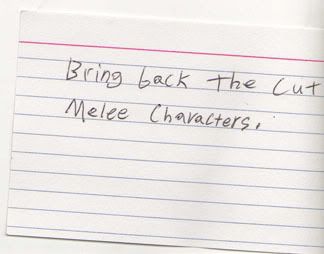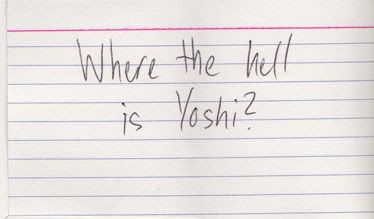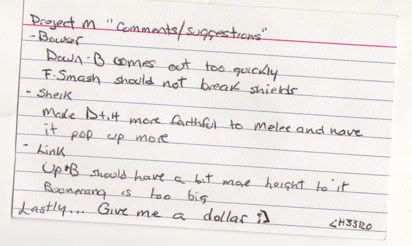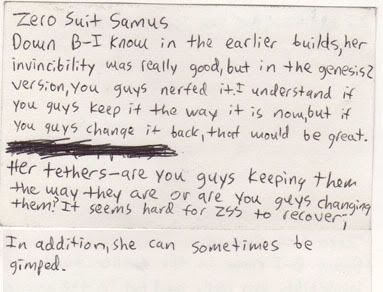ELI-mination
Smash Champion
I use Ike's counter like I use Ganon's utilt.
All the time
All the time
Welcome to Smashboards, the world's largest Super Smash Brothers community! Over 250,000 Smash Bros. fans from around the world have come to discuss these great games in over 19 million posts!
You are currently viewing our boards as a visitor. Click here to sign up right now and start on your path in the Smash community!
Too many times have I triggered a counter from below a plat and got away chock free, proceeding to punish Ike for getting what we like to call a "good read".If they attack from above or below, even just slightly above or below, Ike will miss, and you'll get ****ed over for the lag there too.
 In the right hands, he was quite beastly.
In the right hands, he was quite beastly.It says : smash : so I interpret it the way I like and use it to denote broken things. I don't think smileys are meant to actually "mean" anything, not concretely anyway. For instance,Bubba
what does that smiley even mean
I don't think you even know
 and
and  and
and  ? What's the difference between
? What's the difference between 
pretty well said. I agree with all of this.The subject of "what makes a character viable?" has popped up on Smashmods, and I think it may be an interesting point of discussion when it comes to the direction P:M takes it's characters.
My thoughts on it:
Maybe if it were broken down as such:
Mobility: (The ability for a character to move about)
Ground: (Movement while grounded, includes dashes, WD, walking, certain specials, etc)
-Agility: (Close-Quarters mobility, IE WD'ing and just weaving in and out)
-Speed: (Long-range mobility, getting from A to B quickly to follow opponents or escape and recuperate)
If a character does well in both these aspects, they have overall good ground mobility.
Air: (Movement while airborne, includes Fall Speed*, Air Speed, Air Control, Jump(s), and the ability to transfer from air to ground or vice versa)
-Agility: (Again, the ability for a character to maneuver around their opponent. In this case in order to get higher, get back to the ground safely, or just keep at them from the air or such. Jumping falls in here, including SH height, Full hop, Jump squat, etc)
-Speed: (The ability to get from A to B quickly, weather it's horizontal or vertical in this case. Mainly useful for offstage or vertical movement whereas agility is more useful for horizontal movement along the stage)
*Fall speed is a little awkward as it can either really help a character or hinder them based on which aspect you look at.
If a character does well in both these aspects, they have overall good air mobility.
If a character does well in both categories, they have overall good mobility. A case can be made for characters with extremes in one category to have overall good mobility as well, as one aspect could easily make up for another, such as having enough ground speed to follow up on aerially launched foes, or air speed to not have to run.
Offense: (The character's ability to inflict damage on another & KO)
Strength: (The raw damage and/or power the character can apply per move, as well as the follow-up options allowed)
-Power: (The damage or outright KO-ability potential a character has on average. Slightly hard to pin down, but characters like Bowser would have great showings here with large quantities of Knockback and Damage being slung about, whereas a character like Sonic has overall weaker Power due to having the opposite problem (mobility more than makes up for this, as we'll see in a bit). Other examples include Sheik (good damage, low power) and GW (low damage, high power))
-Reliability: (The ability for a character to actually capitalize on options or force options themselves, building/keeping momentum. Examples include being able to force opponents into edge-guards (Marth), follow up on launchers (Charizard), turn a throw into a near-auto aerial hit (Sheik/Fox) as well as taking advantage of shield (Ike/Falco) )
If a character does well in both aspects, they have a Strong offense. As with most all categories, extremes can make up for shortcomings in others, such as Sonic making up for Power with Reliability in how he can constantly build up hits and take advantage of a foe's position, or how Ganon's sheer power demands respect although his "reliability" factor can be a guessing game at times.
Safety: (The ability of a character to either space efficiently or simply land attacks / recover from misses efficiently)
-Spacing: (A character's reach/disjoint as well as mobility factoring in how easily they can hit the foe while not getting hit themselves. The former can come from both disjointed attacks (Marth/Ike) and projectiles (nearly everybody) to simply control the space around and in front of them. The latter equally controls space, but is a tad more dynamic in that the character moves the space they control around with them, either supplementing or making up for disjoints)
-Risk: (The commitment a character needs to put in overall to perform their offense. Characters like Fox for example have very low risk (good) as nearly all his moves sans Fsmash, Side B and Up B are safe to toss about (ignoring his own momentum and other factors that can be used against him such as fall speed), whereas somebody like Ike takes a lot of Risk to perform his offense due to most all of his moves having punishable lag (ignoring his amazing spacing), or GW as due to the nature of his attacks, he has to commit to them even if he doesn't hit, forfeiting positioning at times. Priority helps in this aspect amazingly, as Marth for example can be baited into commitment, his large disjoints and damage leads to lower risk thanks to priority attacks)
Characters with good Spacing and Low risk have amazing Safety. As always, character can make up for one aspect with extremes with Good Spacing/High Risk (Ike, Link) or Low Spacing/Low Risk(Fox, he has low "real" range).
Overall, if a character has great strength and safety, they are bound to have an amazing offense. Unlike mobility where both aspects are sorta equal, Safety is a bigger issue at higher levels of play than Strength, but both are important aspects in the long run.
Defense: (The ability for a character to avoid offense of others, mitigate incoming damage, and eventually just survive)
Mitigation: (Avoidance, Spacing, Shield-utility and Misc. other tools used to take the least damage/KB possible)
-Avoidance: ("Don't get hit", characters with good avoidance can either just cover their hurtbox with hitboxes really well (Marth) to simply lessend the chance of an opponent getting to them, or simply have the mobility and/or pressure to make sure they're rarely in a position for them to get hit by a combo-starter or a finishing move)
-Shield: (A character's shield options, including Jump, Usmash, Grab, rolls (lol), etc, as well as how well they deal with shield pressure. Special shields can also go here if applicable, such as Reflectors, Absorbers (Earthbound), and traps/minions which can act as deterrents (Snake) or simply take hits for you (Waddles/Pikmin))
Both schools of "Nogethitsu" are great, but higher level play seems to favor Avoidance, at least in Melee. Characters with amazing OoS options however can be equally as effective as it becomes hard to effectively build an offense against them. Characters with good traits in both have good Mitigation vs offense.
Durability: (A character's ability to recover not only to the stage, but from combos, juggles, hits in general and to reset bad situations)
-Recovery: (Actually recovering from off-stage. A character's recovery generally has to cover a good amount of distance (horizontally and vertically) as well as be versatile/safe in order to get by edge-guard attempts once in range of the edge/stage. Recoveries have their own nuances per character, but just like everything else: high safety can make up for low distance (Falco's versatility within X range), and sheer range can make up for safety (try and gimp Peach when she can recover high). Weight, Fall Speed and Air Speed all factor in here as they determine how far you can recover from/get launched offstage)
-Survival: (The character's CC-ability/options, DI, ability to return to the ground and reset in general ties into Survival. In general, weighty characters come with good survival due to Crouch Canceling, but often lack in ability to return to the ground safely or DI out of combos as easily. Characters with good survival include Bowser (he's easy to combo, but can eat many attacks for breakfast, making him tricky to actually "kill") and Jigglypuff (for the exact opposite reason: she's incredibly hard to combo/hit in general, making landing strings or finishers a pain in the ***))
Recovery and Survival go hand-in-hand when it comes to Durability, and lacking in either aspect can really hurt a character unless they really have an extreme in one area, such as recovery options.
Defense is a lot more finicky than offense or mobility (as well as encompassing both) as lacking in one area of defense can get exploited and drag the character down quickly. Having acceptable defense in most areas, or at least really strong areas to mitigate lacking ones makes for a nice safety net for the character to continue fighting.
On the whole, most viable characters have strengths in at least 2 of these aspects, and at least a mediocre "stat" in the third. Polarizing characters tend to have an EXTREME stat one way and the other, with the third being mediocre. Bad characters have like 1 good stat, or just bad all around. In general, the viability of a character should be able to be found by averaging/adding up these factors.
That's the thing: each aspect is connected. Said character could easily supplement their offense/defense with mobility just as they could tie offense into defense and vice versa. Just because each part flows into another doesn't mean they aren't seperate.Kink-Link5' pid='116748' dateline='1354926881 said:Offense and Defense are very archaic ways of examining a fighting game.
Who's to say a character with absolutely absurd mobility isn't defensive or offensive in how that mobility is used? How can it be a separate category when its application goes into both of your other concepts?
In order stated: agility/avoidance, risk/spacing, reliability/avoidance. Fox in this example is actually on the offense as he is the one actually attacking a shield, he's just safely applying pressure. The latter two are examples where the sane move has utility as both offense & defense, but what of characters where the option is really only good on retreat or advance?Like ICG said, Offense and Defense are nearly synonymous, and it isn't just with Jigglypuff. When you're dashing around a shielding opponent with Fox you are doing so not only to avoid something like a grab, but also to pressure the opponent safely to secure a hit. Or when you're wavedashing back while using Marth or Luigi's F-tilt, you do so both to avoid and cause damage.
You keep bringing up similar characters.. but anywho, this is when you get into specifics about the character. Is Fair better used defensively, or aggressively? Do falco's lasers show more use as a mitigator, or used to extend combos? If the former, than more often than not its defensive, if the latter its offensive. But then you have to look at the character as a whole beyond and with those moves included.It's just a really outdated way of looking at the meta concepts of a game, "She's shielding and is thus engaging in the defensive part of the game, he is approaching, engaging in offense." They're antiquated and don't really take into consideration the constant overlap of things that can be considered both offensive and defensive. When you're spacing Marth's fair, for example, s it safely applying damage, or mitigating damage from the opponent? What about Falco shooting lasers? Well clearly doing so from across the stage is defensive, but at what about from mid-way across? Just out of the enemy's range? Just barely inside it? Where does the line get drawn before something stops being offensive and starts being defensive?
The point of these meta approaches to examining the game is to take what are really very simple ideas, and word them in such a way that they can be expressed to others so that the concepts make sense and accurately describe what happens in-game.


range power speed
bb it's all you need
Space control, mobility, hitbox coverage, and frame advantage are all really simple concepts.I think What makes a character viable is alot less complex than people think.
It has to do with a characters design matched against all other characters in the roster. Everything from height, reach, speed, and the tools of that character will ultimately measure his worth in battle. Then there is the matter of the environment. The Stages, legal or banned, Neutral or counterpick also factor in to the general success of any given characters.
In the end it's a matter of pros and cons. If the pros outway the cons or at least break even then the character is viable. If the cons are even or outway the pros the character will end up nonviable. (See Kirby, Pichu, GnW in melee)
All these I went over in my analysis, I must categorized themI think What makes a character viable is alot less complex than people think.
It has to do with a characters design matched against all other characters in the roster. Everything from height, reach, speed, and the tools of that character will ultimately measure his worth in battle. Then there is the matter of the environment. The Stages, legal or banned, Neutral or counterpick also factor in to the general success of any given characters.
In the end it's a matter of pros and cons. If the pros outway the cons or at least break even then the character is viable. If the cons are even or outway the pros the character will end up nonviable. (See Kirby, Pichu, GnW in melee)











The stuff from the last one came true I thinkI hope the PMBR did not let those Genesis complaints cloud their judgement. Many of those seem bogus :/

